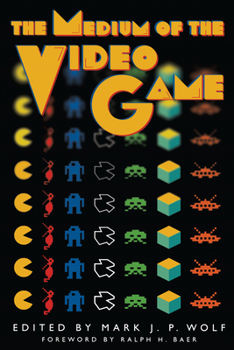The Medium of the Video Game
Select Format
Select Condition 
Book Overview
Over a mere three decades, the video game has become the entertainment medium of choice for millions of people, who now spend more time in the interactive virtual world of games than they do in watching movies or even television. The release of new games or game-playing equipment, such as the PlayStation 2, generates great excitement and even buying frenzies. Yet, until now, this giant on the popular culture landscape has received little in-depth...
Format:Paperback
Language:English
ISBN:029279150X
ISBN13:9780292791503
Release Date:February 2002
Publisher:University of Texas Press
Length:223 Pages
Weight:0.85 lbs.
Dimensions:0.6" x 6.0" x 9.0"
Customer Reviews
2 ratings
mainly thought provoking
Published by Thriftbooks.com User , 16 years ago
25%: review of early days of videogames. including a lengthy foreword by ralph baer where he greedily stakes out his portion of the 'inventor of videogames' title. this part is largely dismissable and you can get better info off of a few google searches 5%: talking about status of videogame as art, and trying to legitimize videogame theory as academic pursuit. also worthless 10%: basic technical talk about how games work. useful information, for the uninitiated 60%: good solid talk about games. including a crazy taxonomization of games based on space/time/narrative/genre, 4 separate analyses each of which errs on presenting *too* many categories, which i found to really stretch the mind even if some of them are a little implausable. it is original and interesting. tho this was written a few years ago, it still contains gems that haven't entered the mainstream dialogue, so well worth reading. also a nice essay on the psychology of archetypes in games. it is interesting too because it is somewhat out of date. you can feel how different the world of gamethought is today than it was in 2001. they use a lot of examples of old games, which is good grounding for younger gamers. curious that the author uses the same examples over and over again (such as the Spy vs Spy game, which is repeatedly mentioned -- why this game?)
... upclose and thorough view of personal cyberspace
Published by Thriftbooks.com User , 21 years ago
Mark Wolf presents a ground breaking and thorough examination of the video game as artistic medium, cultural phenomena, and a meaningful portal for understanding the context of what has become our new digital lifestyle. A "Popular Electronics" January 1975 cover picture of the Altair computer kit prompted the founding of the Homebrew Computer Club, another milestone in history as we know it, which preceded the surge of features and utilities that characterized personal computers with recordable cassette tape drives in the late '70s and early '80s such as Atari, Apple and Commodore. Thus making it relatively easier for individuals to expand creative boundaries, soon to be seen as an inescapable irony allowing some early dark shadows such as "Custer's Revenge" and "FireBug", beginning a long list of collateral, ghastly underworld currents there are now. While we can trust our emerging philosophical inquiries will, in good conscience, examine the pressure to balance those freedoms with responsibility, our generation may so far have not completely charted moral consequences for a healthy society. Obviously video games are not just a fantasy theater, as some might fear, for the furious expression of male adolescent rage fueling new ideologies of terror, misogyny and brutalization throughout the modern world. "First person shooters" can visually and mentally exercise ethnic biases and assorted prejudices that assault human sensibilities and continually challenge the boundaries of those creative freedoms. And we cannot ignore some underground travesties that mimic other "unthinkables" like Columbine, Oklahoma City and Ground Zero.Now, some groundbreaking museum venues are beginning to provide a quiet, safe harbor for contemplating and celebrating the best of this new American media, even while acknowledging the fears emanating from among its dark shadows that can be millions of times more [exponentially] powerful than the limitations we've known of the Gutenberg effect. For example, the chapter "Hot Circuits: A Video Arcade" by Rochelle Slovin, longtime creative spirit and Director of the American Museum of the Moving Image, presents insightful path markers while continuing in celebrating the best in American media history. AMMI's brilliant series begins with "Hot Circuits: A Video Arcade" 1989, distinguished by its marvelous gallery (and online, ammi.org) presentations continuing through "Expanded Entertainment" 1996, "Computer Space" 1998, and " Digital Media" 2002, marking a significant place on an historic trail of kinetic luminism preceded by other remarkable mile markers such as Wilfred's "Lumia Suite" at MOMA in the '60s, and Nam June Paik's debut at NYC's New School in the early '60s (foretelling his magnificent AMMI installation today). The history of man's cultural kinetic lightworks and precursors harkens back even to the to the magic lantern Phantasmagoria of the Renaissance and the Shadow Puppetry Theatre in Bali 1000 years earlier. As sign






